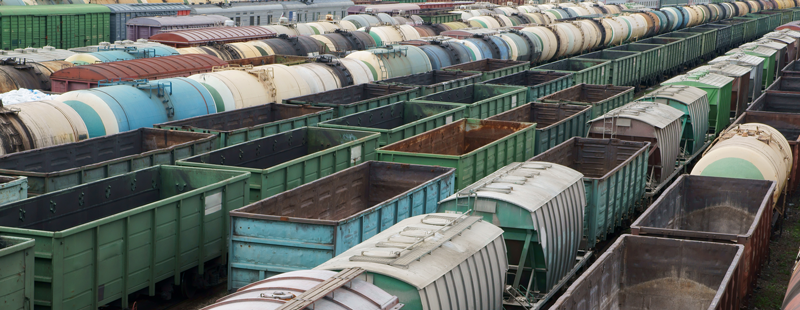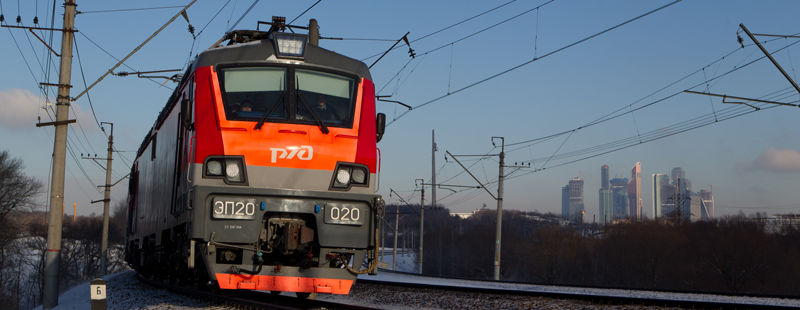Service functions
Rolling stock fleet
Railcar fleets

One of the main outcomes of the state railway transport reform programme was the creation of a private freight car fleet of approximately 1,200 thousand units of rolling stock, which by December 31, 2013 had more than 1,800 owners . During 2013, the freight car fleet increased by 48.7 thousand units or 4.2%.
Russian Railways car fleet includes 54 thousand units of rolling stock or 4.5% of the total number (including 5 thousand of reserve and, – 6,300 subleased gondola cars previously booked as the property of OJSC FGK) since March 2013.
In July 2013, the fleet of LRF railcars was returned in full to FGK, which is the Group’s largest car fleet operator.
in 2013 was
Structure of the car fleet of Russian Railways and subsidiaries and affiliates in 2013
| Companies | Number of cars, thousand | Share,% |
|---|---|---|
| Total number of cars | 252.9 | 100.0 |
| Cars of Russian Railways | 54.2 | 21.4 |
| Cars of subsidiaries and affiliates | 198.7 | 78.6 |
|
162.6 | 64.3 |
|
25.6 | 10.1 |
|
5.8 | 2.3 |
|
2.8 | 1.1 |
|
1.8 | 0.7 |
Currently, and according to calculations, 900-950 thousand freight cars are sufficient to carry required and prospective traffic. As such, the current freight car fleet is excessive and the additional 290 thousand cars limit the capacity and flexibility of the infrastructure, impede the traffic of freight flows, and decrease the speed of freight delivery and the overall efficiency of the fleet.
Structure of the Russian freight cars fleet, thousand units
Structure of the market of freight cars operating by traffic volume,%
Structure of the market of freight cars operating by freight turnover volume,%
Compared with the maximum volume of loaded car-kilometres achieved within the borders of the RSFSR in 1998, the current indicators are 35% lower. At the same time, the number of empty car-kilometres increased by 2.9%. Railway facilities are largely used not for freight transportation but for moving empty cars based on the commercial interests of operators, and freight car performance has significantly decreased.
Every 50 thousand cars within the Russian Railways infrastructure that are beyond the rational value cause the following negative consequences:
- Additional maintenance of 130-140 train locomotives and correspondingly providing for 600-620 locomotive teams during the year;
- Additional consumption of 540-570 mln kilowatt hours of electricity for starting up to speed and slowing down freight cars after unplanned stops;
The available excess of rolling stock affected the growth of car turnover and led to a slow down of the speed of freight delivery. It also resulted in additional expenses for Russian Railways of more than RUB 19 billion.
Furthermore, despite being at a historic high in terms of size, the current car fleet does not provide stable freight traffic, which is the first priority for all low margin and socially important types of cargo.
Due to the unwillingness of rolling stock owners to provide their cars to shippers for the transport of low margin freight, Russian Railways has been forced to arrange a leased car fleet.
The consolidation of a part of the private park under Russian Railways management allowed us to solve the issue of car fleet placement within the rail network based on the real needs of shippers; providing speedy relocation of empty cars into handling regions in order to organise the traffic of low-margin and socially important freight.
By the beginning of 2013, the total number of gondola cars of the leased railcar fleet (the property of FGK) amounted to 74.5 thousand units (15% of the total number of gondola cars of various kinds of property within the fleet network). During the period from January to July 2013, 22.5 million tonnes of freight were transported in gondola cars of the LRF railcars (360 thousand of car-dispatches). Construction materials and stone coal accounted for the majority of freight volume.
Reserve cars are mainly used for low margin public service traffic for municipal and electric utilities authorities and the Ministry of Defence. These segments are not attractive for other owners of the rolling stock. The proportion of this traffic in terms of overall freight turnover for LRF railcars amounted to approximately 60% in 2013. At the same time, the freight of third class tariffs amounted to just 6.7%.
The reasons for the decrease in demand for the fleet of LRF railcars were a reduction by the owners (operators) in the cost of providing cars for transportation due to a surplus of gondola cars in the market and the need to pay for use of the cars from the fleet of LRF railcars while they were under freight operations. Russian Railways therefore took the decision to return the reserve gondola cars into the operation of FGK. In accordance with Resolution No 1467 of the Government of the Russian Federation dated December 28, 2012, the fleet was fully returned to its owner in July 2013.
Structure of freight transport by the fleet of LRF railcars in 2013,%
Locomotive fleet

The supply of new locomotives over the year allowed Russian Railways to gradually introduce its operated locomotive fleet and relocate it to railway grounds, leading to growth in freight turnover, and the removal of fleet units that had outlived their standard operation time.
In 2013, Russian Railways operated a fleet of 14,380 locomotives.
During the year, 804 new locomotives were supplied to the network. This included 421 electric and 383 diesel locomotives. The increase in supply of new locomotives was 51.1% compared to 2012.
Of the 804 new units, 82 were innovative. These included electric freight AC locomotives with an asynchronous tractional drive 2ES10 (40 units), diesel freight locomotives 2TE25A (12 units), and passenger dual-voltage electric locomotives EP20 (30 units).
Structure of the operated locomotive fleet in 2013, units
Key quality indicators of the rolling stock operation in 2013
- Freight train service speed increased by 0.8 km/hour (+2.2%) compared to 2012, reaching 36.8 km/hour; operating speed increased by 0.4 km/hour (+0.9%), reaching 45.6 km/hour
- The average weight of a freight train was 3,911 tonnes (+0.5%). This growth was achieved mainly by increasing the number of connected trains. 22.2 thousand trains of increased length were dispatched within the railway network (+35.8%)
- The average daily productivity of an operating fleet locomotive within the network amounted to 1,820 thousand tonne-kilometres gross (+1.6%). This growth was achieved mainly by increasing average daily mileage to 591.3 km (+1%) and decreasing the percentage of false mileage of an operating fleet locomotive from 12.6% to 12.3%.
Structure of locomotives procurement in 2013, units
| Amount | |
|---|---|
| Locomotives, total | 804 |
| Electric locomotives | 421 |
| Electric freight AC locomotives | 157 |
| Electric freight DC locomotives | 164 |
| Electric passenger AC locomotives | 50 |
| Electric passenger DC locomotives | 50 |
| Diesel locomotives | 383 |
| Diesel freight locomotives | 138 |
| Diesel passenger locomotives | 41 |
| Diesel shunting locomotives | 204 |
Traction rolling stock procurement, units